inapoi la SURSE Michael Laitman – link
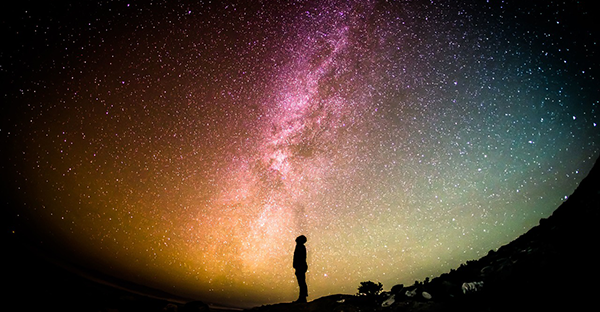
- Bold and in quotes: Original text of Baal HaSulam
- Regular: Commentaries of Rav Laitman
- lowercase italics: emphasized words
- Capitalized italics: transliteration from Hebrew
Today we will discuss the structure of Adam ha Rishon (The First Man). We all hear, and supposedly know that there is such a thing as The First Man. It is written about, we talk about it, but who is Adam? When we talk about something, we always refer to it from the point of view of the created being.
Who is Adam ha Rishon? As we discussed previously, what has been created is the desire to receive, the desire to enjoy. Because the Thought of Creation, creation itself, is the giving of joy to the created being, what is missing is only the created being that will receive all of this benevolence. This created being is called Adam ha Rishon, “The First Man.” What is “First”? Is there a second? A third? How many more of these are there? There is only a first, and as we attain, as we start to develop a sixth sense and become included in the Upper World, we begin to sense it, to see what exists in reality outside of us, beyond our five senses. We arrive at a structure that we can see and attain, called Adam ha Rishon.
How did the Kabbalists reveal it? How will we have to reveal it?
We are in this world, and we sense what is called “this world” with our five senses. Our experience cannot grasp anything other than what our five senses transmit to us. We can add to them by using all sorts of instruments, such as microscopes or telescopes, but whatever we add to our five senses are only additional tools that expand the range of our sensation into matter or space. It means that we can then increase our overall understanding of what time, motion, and space, are, as well as our matter, which is experienced in the five senses.
No matter what we build with these tools, it will never give us anything outside of the five senses. This is because, if we exist within the five senses, we do not even know what we lack, or what we can reveal.
If I were to know that I am now in my world, like in a closed room, and that outside of this room there is something else that I cannot sense, then perhaps I would try to somehow feel it, maybe by building some instrument, or by somehow transforming myself and developing a sense for it. But I do not know what is beyond this world. So whenever I search, I always do it out of the five senses, and these five senses enclose me in this structure called “this world.” This is why it is never possible to exit from this world in an ordinary manner, without developing an additional sense, a sixth sense.
What is the sixth sense? How is it constructed? If we develop it we will reach the structure of Adam ha Rishon, the Thought of Creation. We will then discover what the Kabbalists tell us. It is constructed in a simple manner. We are separated from these upper forces by our very “body,” the five senses. If we construct an additional sixth sense, in the same way we construct ourselves via our five senses, the point in the heart will awaken in us. We will then be able to break out of the body, out of our ordinary senses, and through this point, feel the Upper World.
The emergence into seeing and feeling the Upper World includes two actions. One action is that my desire to feel the Upper World is greater than my desire to experience the five senses, this world. My sensitivity to the Upper World should be greater than my sensitivity, my attitude toward this world. The first action is called Tzimtzum Alef (the first restriction). When a person desires to climb over this wall that separates him from the Upper World, that person has to perform a restriction on himself. What is a restriction? It means that whatever is above nature will be more cherished than what is within nature. Following the restriction, the person needs to add more heartiness, more feeling to what is outside of him. What does it mean, heartiness and feeling? It means that the person will sense what is outside of the five senses through an additional sense, which is built by the person himself. The entire Upper, Spiritual World, is constructed above our five senses. It is impossible to have a preference for sensing this world, and at the same time, also want to feel the Upper World.
Therefore, the Light, the Upper Force that comes to us and corrects us, increases this point in us—it performs a “double-action.” The first involves this world, and the second involves the Upper World. When a person begins to sense the spiritual world, he begins to perceive a very special formation. He starts to perceive the collection of souls that are all included in one single soul called Adam ha Rishon. How? If a person leaves himself, his world, and his walls, so to speak, and acts outside them, the person then feels only Upper Light. How? In what vessel? Here we encounter a very interesting occurrence —the Light is not felt outside the vessel.
We have said that the Upper Light created a desire to receive—it is in the desire, and is only felt in the desire. Outside of the desire it is not possible to feel anything. It is our sense. The desire can be pointed either toward ourselves or outside of ourselves. When a person exits himself, he starts to feel the Upper World in an external vessel. What is an external vessel? It is a desire that is directed at other souls, and which senses them. We never sense outside of the vessels, everything is always felt inside them.
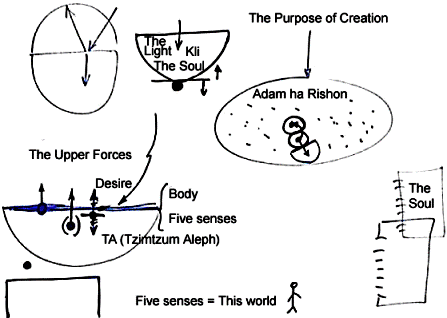
Drawing No. 1
As we drew [points to the drawing], in the same way that I sense in my five senses, in my box, I also feel the Upper World in the sixth sense that I develop. But the sixth sense, this inner sensation which is called “a soul,” is developed by me in relation to the other souls. In this way, if a person can exit his five senses to a “sixth sense,” it is considered that he is able to somehow connect with other souls and feel them. If a person feels, out of his soul, what happens in another soul, through a connection to it, then this is defined as his Upper World.
Let me try to explain it in different way. In relation to me, “Upper World” means that I expand myself into a connection with all the other souls. As I join them to me, I actually form the vessel, the Kli, of my soul, inside which I feel the appearance of the Light, the Upper Force. There is no other way to feel what Kabbalists define as the Upper Light, Upper World, soul, Eternal World, Upper Force; anything that can be imagined and expressed with words which is beyond this world, except in the vessels of the rest of the souls. This is why the rule “love thy neighbor as thyself” is considered to be “a great rule in the Torah,” the main rule for the appearance of the Light in man’s vessels. This is also why Arvut (mutual guarantee) is the condition for this to happen. In other words, the connection of the souls is the condition in which the Upper Light, the Upper Force, will be revealed. A person, who begins to perform a restriction over his five senses, and develops a desire beyond them, actually penetrates the vessels of other souls, and it is then considered that he becomes a Kabbalist.
So with the annulment of his self, the person reveals this general vessel called Adam ha Rishon (the First Man). Why does the person call it “the first?” Because it really is first in relation to all the other souls. The Kabbalist reveals that everyone is actually connected through this formation of The First Man, Adam ha Rishon. That is how the Kabbalist describes it, because it is the prototype, the model, the initial structure in relation to every single soul. Anyone who exits the five senses, who rises above them, above this world, actually discovers the same structure of Nishmat Adam ha Rishon, “The Soul of the First Man.” Its revelation is gradual, from small to large, through stages of attainment within this structure, that are called Nefesh, Ruach, Neshama, Haya, and Yechida. That is how the entire vessel is revealed.
The entire vessel of Adam ha Rishon, which is filled with all of the Light and which includes all of the corrections, is called “The Endless World,” or “The World of Infinity,” Olam Ein Sof in Hebrew. That is why Kabbalists tell us about this Adam, that it is actually a great vessel, a great desire to receive of which each of us is just a part. Each person that reveals this picture, discovers the same general structure. How can the general structure be revealed? It is revealed to the extent that a person can participate in it as an integral, active part, like every single cell in our body which assumes an active role in the body’s functioning.
All bodies, all natural systems, both upper and lower, are constructed in such a way that there is no organ, no ligament, bone, cell or any other part that serves only itself. All parts serve the rest of the body. If a body part begins to function for itself it becomes malignant and consumes everything that is around it. By doing so it eventually dies, since it consumes its own vital supplies. This is what happens at the corporeal level, the level of our matter.
In spirituality we all are within that structure of Adam ha Rishon. We eventually find out that the Creator or the Upper Light created only one structure. This single structure functions through all of its interconnected parts in an integral way, just like the human body. It is just that, we here, who are in this structure, suffer from blurred vision. We do not truly sense ourselves. We are simultaneously in this structure, but we are out of it too, behind five screens. It means that, in our awareness, we are not within this structure of Adam ha Rishon. The difference in our vision, our sensation, manifests in our actions of receiving and giving that each of us performs toward the others, in what we feel and in the way we act. This difference is called “the descent through five worlds.” That is how it is named in relation to us.
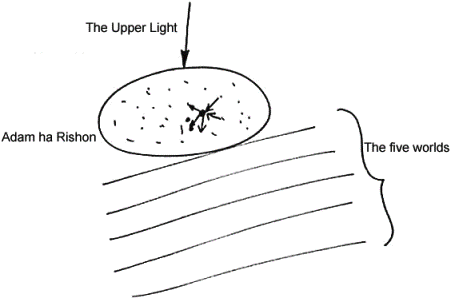
Drawing No. 2
And truly, each one of us, although we do not see it or know it, is an inseparable part in the structure of Adam ha Rishon, acting completely in the form of bestowal, existing the world of Infinity. “World” (Olam) is intended to describe this state of Adam ha Rishon which is filled with Lights, eternity, wholeness. It is only in our consciousness that we feel ourselves to be in some different state, in a different place. That is why our state is called “unconscious state” or “imaginary world,” which is experienced by us as some concealment.
Kabbalists, who start connecting with all other souls according to the rule of “love thy neighbor as thyself” and according to the rule of Arvut (mutual responsibility), start to feel this state of Adam ha Rishon accordingly. Once this state begins to be felt, when it gradually becomes clearer, the delusion, the blurring dissipates, the vision becomes clearer and then this structure is revealed more and more through a total of five levels of revelation. The concealment turns into revelation. We gradually draw nearer to that structure through steps, or levels of concealment, a transformation from concealments into revelations. All of these levels become revealed; they reveal to us that structure of Adam ha Rishon.
When a person crosses the “barrier,” even if only a little, into the Spiritual World, the person can then already sense the structure of Adam ha Rishon at each level, at some degree of blurring which is called “his world”—the extent of “his concealment.” It is always like this. Crossing the barrier is the same as connecting, to some extent, with all other souls.
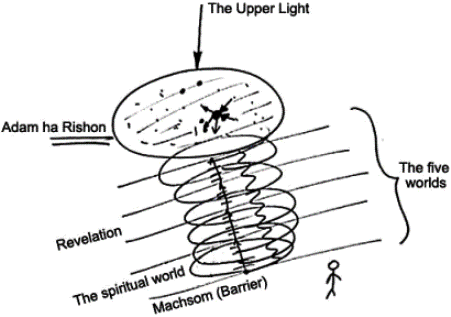
Drawing No. 3
To sense the Upper World is the same as to connect with the other souls as an integral cell in the body of Adam ha Rishon; in a conscious way, willingly, while being aware of this doing. This is what becomes revealed. We are all inside this structure of Adam ha Rishon, and all of the Kabbalistic books, and all of our revelations, are only about this.
The worlds are levels of concealment in which I find myself. The souls are what I reveal in this world. The spirits, angels, shrines, heavens; everything that Kabbalah discusses refers to forces acting inside this solid, rigid and unchanging body called Adam ha Rishon.
Rabash once gave a good example regarding the fact that since we are unable to see clearly, we seem to cause trouble to one another. He talked about a friend of his: “I have a friend who owns a restaurant. It seems to him that he wants money. This is the extent of haziness that he experiences. So in order to have a lot of money he sets up the restaurant and makes very good food, and invites people, advertises, all in order to serve the customers. All of this is done in concealment of the fact that he actually loves them, deeply within himself. It will later be revealed to him—after he passes through double concealment and single concealment, through all of the levels—that he had always been in a state of one hundred per cent bestowal, and it was just that he was living a lie. He lied to himself unconsciously, that he was doing it in order to make money, or to achieve other things.”
What does this example illustrate for us? It tells us that we are situated in Adam ha Rishon, in that structure, and there is no distance, no time, and no change. We just need to open our sense and start feeling this single state that exists. Then we will discover that we exist in falsehood, opposed to the true state.
We spoke about the levels of revelation. There are a total of five worlds. In each world there are five large levels, called “Five Partzufim.” In each Partzuf there are five additional levels, called “Five Sefirot.” So in each world there are twenty-five levels, and there are five worlds, yielding one hundred and twenty-five levels of revelation. That is what a person passes through. What does revelation mean? The person cleanses his sense, and in so doing, begins to see where he really exists, just as an unconscious person gradually regains consciousness and then sees where he is. That is why this state we are in is defined as an imaginary world, because it is completely imaginary.
The spiritual worlds can be known partially. If I reach a certain level, a small attainment of existence outside of this world, some spiritual degree, then within that level I know that I have the correct relationship, the correct structure. It is still like a child who is not yet familiar with the world, still wanting to discover it. The child has some relationship to the world, knowing that hecan only manage with a small familiar part of the world. The child knows that up to some degree, he can deal with the world, but beyond it, he is afraid, he is not yet ready for it. That is why these worlds are called Olamot, from the word Haalama—concealment. It means that whoever is there, discovers that he is in concealment, and that there is more he has to reveal. Our world, our state in which we do not know anything, is defined as an imaginary state, an imaginary world. It is entirely the fruit of our imagination, and everyone in it is living an illusion. All we need is to start elevating above ourselves, above our five senses.
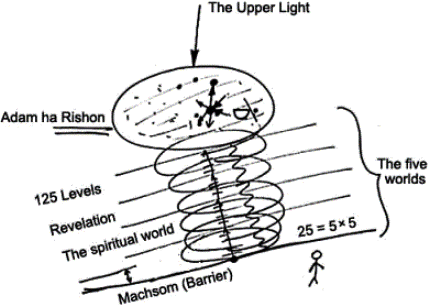
Drawing No. 4
What is the extent of the connection between us and all the other souls? It seems to me now, that if I have to give to someone, or think about someone, connect to someone, it will make me feel a certain deficiency. It will damage me, it will damage my pride; I will have to share, to give, I will have to reduce myself in relation to the other. In other words, a person only feels his own tiny vessel with the five senses. He does not sense the point in the heart, only his small vessel.
Performing a restriction on the five senses does not mean avoiding anything in this world. It means paying attention to the development of the point in the heart, and not to the five senses. The five senses are called “natural senses,” and they can thus receive whatever is natural for them to receive. The point is not to invest effort in fulfilling them, but the effort, the attention, should be invested in developing the point. Whatever the five senses demand in the meantime is probably a corporeal necessity for sustaining existence.
Until what point or state do we have to exist in the body? It is as we have discussed; until we are included with all the rest of the vessel, with all the rest of the souls, in a complete and integral way, one hundred percent. Why is it so? It is because only then I will not need to also exist in my corporeal vessel. I will not need to determine my relationship to both some soul and my five senses. I will then begin to sense that my body, the way I currently experience it, does not exist, and these senses will be called “virtual senses.” It is just that I still cannot establish that as of yet.
Rabash gave a very good example about this as well. He said that a person in this world cannot discern between the states in which he finds himself. He described a man who worked as a mover of goods with his horse and carriage. He used to take merchandise from one place to the other with his horse and carriage, he had a family, a wife, kids, he was happy. He earned a good living, and he was happy, a simple man. Suddenly, a tough time came, there was an epidemic, everything began to go wrong, the children died, the horse died, and eventually the man died as well from his deep sorrow.
Then he arrived at the Supreme Court in heaven, and they had to decide what to do with such a soul. He was a good man, he didn’t harm anyone, and he only did what life demanded of him to do. What can be given to him? Giving can only be done according to a person’s desire. What did he desire? He just wanted his family, his house, his horse and carriage, and his simple job. This is a real example, because how can they give someone in the next world more than he or she desires? So he received what he wanted. He was given the illusion that he existed and that he had a wife and children, a house, a horse and carriage—all is well—and he enjoyed it.
But the question is this: how can he discern whether he is dreaming or whether he really is in this world wondering around with the horse and carriage, having a family, children? Are there any ways to distinguish one from the other? How do we distinguish between a dream, an imaginary world, and between the real world? We don’t have that ability. That is why, once we reach the sensation of the spiritual world, we begin—as we ascend through the levels and reveal part of it—to understand that there is another part which is still concealed. By seeing that we still need to reveal something which is concealed, we accordingly begin to sense how much our world is imaginary.
[Rav points to the drawing] I rise through one hundred and twenty-five levels of revelation. Here is my material, corporeal world, and as I rise, at every level, I still need my body. This is because, on my body, I construct my free choice to go to the next level, to connect with the other souls at each and every level. This choice needs to be made from my lowest level and that is why I must still be in the body and reincarnate time and time again. To the extent that I elevate from level to level, I begin to see the world—through one hundred and twenty-five levels—as being more and more imaginary. If I rise by one level, I see this world as imaginary to the extent of that one level. If I rise by two levels, I see it as imaginary in the extent of the two levels. This means that, with the same vessels I acquire, I also become capable of distancing and relating to what I see here as imaginary. Accordingly, I relate to what I see here as obligatory, I see how this picture that is in front of me is imperative, helping me to place myself correctly in my spiritual level of attainment.
That is why there is great need for this world, for this reality in which we now exist, imagining ourselves in our bodies, in this great world, the universe… But we should once in a while remind ourselves that in relation to this world, we are in the same state as that mover with the horse and carriage. In relation to others, we are like the restaurant owner, who thinks he is actually acquiring honor, money, all the pleasures of this world, while in reality it is all an illusion that he is experiencing as the Upper Providence obligates him to function within the structure of Adam ha Rishon.
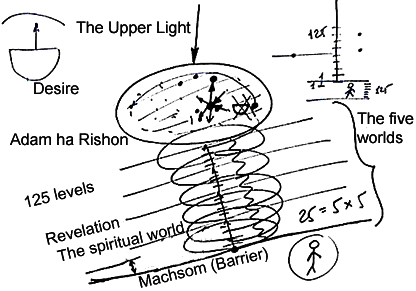
Drawing No. 5
This structure of Adam ha Rishon is not a homogeneous, unified structure. It is just like the human body, where there are higher and lower functioning organs who are more or less important in the body’s operation. That is why each one who goes through the states of revelation experiences them differently from others. The principal is the same, to constantly develop the sixth sense and its connection to the emergence of the souls. But each person has a different path. It is written: “No day is similar to another; no hour is like the next”—no one can be similar to others in his soul or path. That is why Kabbalists do not tell us in their true Kabbalistic books about the pictures that they see. They only tell us about the corrections that we have to apply on our vessels, in order to reach the same world, level or state that they see.
Baal HaSulam tells us this: “The truth will be rewarding to you, to speak with no disparity, and all that you will see will be seen by your own eyes and no one else’s.” We cannot share this depiction with anyone else; we can only discuss its fundamentals, its components. So we need a great longing to see the Upper World, but the revelation of it is individual, it has to be done by each one of us. It is the same as when one says to another, “taste this; it is sweet, very tasty.” Since we have shared senses that are similar, we can then assume that if I taste it, I will sense the same sensation as well. But the inner sensation which is perceived by the desire cannot be compared among ourselves. It is the same in the Spiritual World. Each Light is revealed in an individual vessel, and therefore, it is not possible to discuss flavors any further than what is revealed in the desire. The inner impression from every desire is something personal that we can never compare among one another.
Question: Who or what is the Creator in this picture of the Spiritual World?
I don’t know. Here, we speak about man revealing the world. I have never heard about someone, or some great hand, ever coming down through the clouds to give us some sacred book.
There haven’t been any such discoveries, and what we try to visualize as images is improper. It is simple—do not make yourself any image or figure. Such people are incorrect. We have never seen such things and we must not believe them. “One must only judge according to what one sees,” that is the rule.
How come some people sometimes see unnatural things? Well, they are not unnatural, they are also part of nature. There is nothing that is above nature, there is only the corporeal nature and the spiritual nature. It can be divided into two. The nature in which we were born, and in which we feel this world naturally, can be studied further through research and experiments. However, everything we discover is the world that we sense—the sensed reality—because that is how we are structured. We reveal it according to our desire. All of our substance is actually desire. Atoms desire to sustain themselves, plants want to grow, a greater desire in living creatures makes them wonder around, and an even greater desire in human beings makes us feel all kinds of different desires. It all depends on desire; the entire substance of creation is desire.
Any force that is in matter, actually determines what form the matter will assume. If we could, for example, take a pencil and inject into it additional power, additional power of will, suddenly the pencil would become a vegetative organism. With even more power it would become a living entity until finally it would become human. There are some who actually think, according to Darwin’s theory, that such evolution is possible. We know, however, that it is not possible, because desire cannot evolve in an existing object beyond what already exists in its defined state. The desire that is in an object manifests to the outside as its form, but it is not added to it during its existence, it is simply revealed by the object. In human sperm, for example, everything that is necessary for it to create an adult person is included in it. It is not possible that one level of desire will emerge out of another level and evolve out of a different essence. That is why inanimate, vegetative, living and speaking are clearly defined and cannot change. Both The Ari, in The Tree of Life, and Baal HaSulam, in the third part of Talmud Eser Sefirot, tell us that there are still, vegetative, animate, and speaking levels, and there are some discernments in between them, such as corals that are in between still and vegetative, so called “Kelev ha Sadeh” (described in Talmud) that are in between the vegetative and the living, or a monkey…
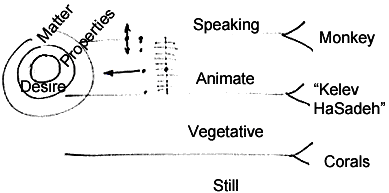
Drawing No. 6
These levels are also permanent levels, only they are intermediary. If we look for the example at the level of living, as many creatures as there are, they all have their place here, from the tiniest ant or some frog, a lion, and so on, until we arrive to the monkey. The monkey may be at the boundary between the animal and the human, but it can never change, go up or down. It has to remain at its level.
You can take any animal, and through training, add to it all sorts of habits, but in that you do not develop in it any additional desire. So do not get confused. We always work only with externality, with what is already defined by nature and can never change. There may be many mutations, all sorts of external forms, but we can never change the desire. There is a desire, and the desire determines the properties, and in these properties it determines the external attributes of the Matter, that is, the Forms of the Matter. In the Wisdom of Kabbalah this is called “Matter, and Form clothed in Matter.” Abstract Form and Essence are not discussed by us. So the entire discussion is about desire. We read in “The Preface to the Wisdom of Kabbalah” that the entire creation, including anything we can name, except for the Light—the Upper Light which is what we call the Creator—is desire. Everything else beside desire is the Upper Force. It determines the desire, and we call it the Creator.
So there is some energy field, which we call “Upper Force.” Why is it “Upper”? It is “Upper” because from it emanates the desire—it precedes the desire. That is why we call it the Creator. How do we know about this? Kabbalists, who developed their desire to this level of perception, have told us about it. A person can develop the desire accordingly, and discover that the level of speaking includes many levels of desires within the entire humanity. We usually talk about a pyramid structure. There are many people with simple desires, and very few with elevated, unique desires.
However, changing the desire within a person and developing it, is not related to this. Each person must correct and develop his own desire. Such an action is enough in order to become included in Adam ha Rishon, because within this structure of Adam ha Rishon each one needs to correct his relationship to the rest of the desires around him or her. There are five parts in the structure —Keter, Hochma, Bina, ZA and Malchut. If I belong to a certain part, I have to correct my relationship to all the other parts of Adam ha Rishon from where I am. I need to become a corrected, integral part, acting correctly within the structure, and providing everyone else whatever they need from me, just like a healthy cell in the human body.
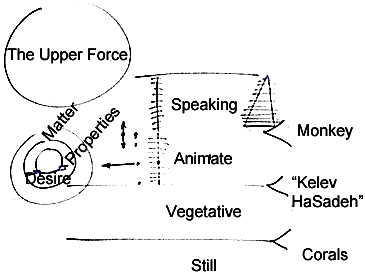
Drawing No. 7
An eye is only expected to receive light and transfer it inside. I cannot add to it functions for which it is not intended, but if it is functioning correctly, then the entire body enjoys it, just as when we function correctly, each of us enjoys the health of the entire body of Adam ha Rishon, as the Light becomes revealed in its entirety. Individual desires cannot be changed, and that is why, in this world as well, as we have discussed previously, dissemination should be passive. People should be shown that it is possible to correct ourselves, to reveal the soul. Education should only take place through example, by setting a good example. A person will grasp as much as he or she can grasp, but no one should be coerced into anything. That is why ethics and education, according to Kabbalah, are opposite to each other.
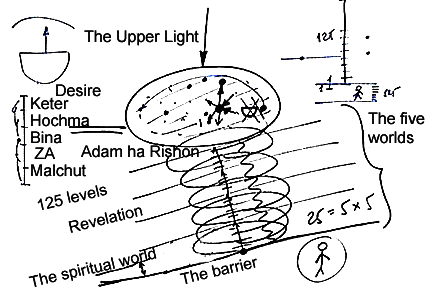
Drawing No. 8
A person starting to develop spiritually should not be told anything. He needs to see different examples about choosing development through free choice. We cannot change desire, the person must choose on his own how to develop the desire. There cannot be any external enforcement other than an example. The choice has to be internal. The development is of “man” in his “environment.” The way in which man uses his environment determines his use of his desire. Man’s desire, his properties, are given from birth, but through the use of the environment, man can better know how to develop his attributes.
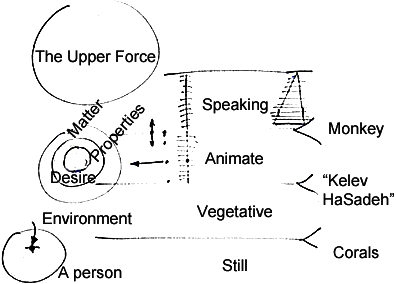
Drawing No. 9
Question: Why doesn’t the Upper World open up to a person while he is still invested in the pleasures of this world as well as the Upper World?
I never said that it is so. It is written that “whoever is greater than his friend, his evil inclination is greater than him.” It is also written that, from the time of the destruction of the temple, the flavors of BYA remained only for elevated souls, for the completely righteous ones. So this is not true.
On the contrary, our world does not become any more inferior for those who rise up the levels, because a person has to have free choice to choose the Upper Worlds while still within the physical body. At every level the person has to use the body as well. We have read an article about how long a person has to reincarnate, attain a corporeal, external form. It has to continue until one goes through all the levels, and reaches the end of correction. Why is it so?
What is an “external form”? It does not mean this body. It means the five senses, with all of the pleasures that can be revealed in them. Through the five senses the person elevates, and his or her experience changes according to his or her level. So it is not possible to say that, as the person emerges into the smallest spiritual level, this world immediately becomes dark and worthless for him or her.
On the contrary, as written in The Zohar, Rabbi Shimon, before reaching the last level before the end of correction, felt himself to be “Shimon from the market.”
We need to understand what “Shimon from the market” means. It is not some merchant in the market. It means that he felt this way, with all of the obstacles that he was facing, having to make the free choice at the level of the end of correction, after going through all of the levels and being in GAR de Atzilut. His state was not something that we can imagine, and that is why Rabash wrote such an article about reincarnations.
The existence in our body is very central and our body, with all of its demands, should not be disregarded. It is the correct relationship, the right combination of the world in which a person lives and the spirituality that is revealed to the person that determines the person’s behavior. That is why no one can judge anyone else by external appearance, since no one can know the other’s inner world and what is revealed there. If you would have seen Rabbi Shimon at the time of the desire of “Shimon from the market,” you would have seen his external level, while not knowing his inner sensations.
These issues are still too elevated for us. We will gradually come to understand them. For now we will stop, and next time we will discuss the three states, A, B and C, and go over our entire spiritual as well as corporeal history, and how it is revealed to the Kabbalist.
inapoi la SURSE Michael Laitman – link
